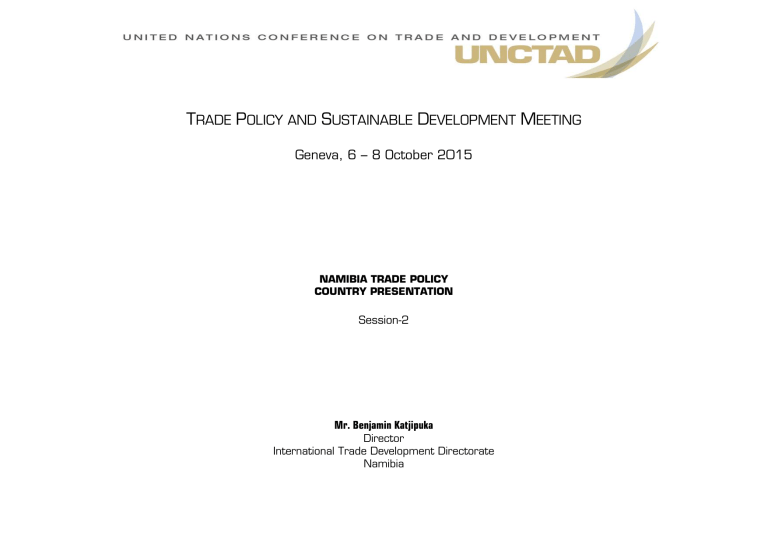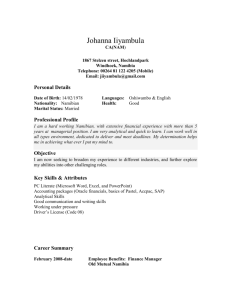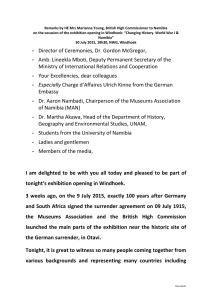T P S D

T RADE P OLICY AND S USTAINABLE D EVELOPMENT M EETING
Geneva, 6 -- 8 October 2015
NAMIBIA TRADE POLICY
COUNTRY PRESENTATION
Session-2
Mr. Benjamin Katjipuka
Director
International Trade Development Directorate
Namibia
NAMIBIA TRADE POLICY–
COUNTRY PRESENTATION
1
By Mr. Benjamin Katjipuka -
Namibia
1. INTRODUCTION
•
Currently Namibia does not have a written Trade Policy .
It is in the process of developing its National Trade Policy through the technical assistance provided by UNCTAD.
•
All its trade activities are informed by the trade arrangements that Namibia is signatory to, such as:
SACU
SADC
SACU-EFTA FTA
SACU-Mercosur
SACU-India under negotiations
EU-SADC EPA
COMESA-EAC-SADC Tripartite Free Trade Area under negotiations
WTO
2
1. DEVELOPMENT CHALLENGES
CONFRONTING DEVELOPING
COUNTRIES
•
Namibia has a small domestic market of about 2.2 million people.
•
Classified as upper-middle income country but has highly skewed income distribution.
•
High unemployment rate of about 27.4% and is confronted by poverty as well.
•
Given its small domestic market, economies of scale are imperative.
3
1. DEVELOPMENT CHALLENGES
CONFRONTING DEVELOPING
COUNTRIES
•
Namibia is in the early stage of industrialization and has set Vision 2030 as a development path to become industrialized economy.
•
This could be achieved through a five years
National Development Plans whereas the country is currently in NDP4
•
Namibia has a small industrial base, depending largely on commodities and export of raw materials.
4
NAMIBIA SIGNED THE FOLLOWING
TRADE AND ECONOMIC COOPERATION
AGREEMENTS
5
2. SALIENT FEATURES OF “SUCCESFUL”
TRADE POLICY MIX
•
Namibia Constitution Article 144 states that international agreements binding upon Namibia
“shall form part of the law of Namibia
•
There should be synergy between domestic policy and rights and obligations of international treaties.
6
2.SALIENT FEATURES OF “SUCCESFUL”
TRADE POLICY MIX
•
A policy mix is important for successful trade policy.
•
Industrial Policy informs trade policy, investment policy , fiscal policy, agricultural policy etc.
•
All these policies should be mutually reenforcing to have a successful trade policy.
7
2.SALIENT FEATURES OF “SUCCESFUL”
TRADE POLICY MIX
•
Trade Facilitation is equally important to reduce cost for doing business, and to support an effective Trade Policy implementation.
•
Policy Coherence is very important.
8
2.SALIENT FEATURES OF “SUCCESFUL”
TRADE POLICY MIX
•
SADC has now adopted its industrial strategy and a roadmap, and is now in the process of costing and implementation.
•
Similar developments have been mooted in SACU and COMESA-EAC-SADC Tripartite FTA.
•
The ECA report 2015 highlights “industrialization through trade” as the future development trajectory for Africa.
9
3. HOW CAN NATIONAL TRADE POLICY
OPTIMIZE THE CONTRIBUTION OF
DIFFERENT SECTORS TO ECONOMY
•
Trade is a means to an end, and that end is development.
•
Namibia in its NDP4 has identified 4 strategic sectors to induce growth. They are:
Agriculture i.e. Agro-processing
Mining
Tourism, and
Logistic services
10
3. HOW CAN NATIONAL TRADE POLICY
OPTIMIZE THE CONTRIBUTION OF
DIFFERENT SECTORS TO ECONOMY
•
In agriculture, we support value addition through creation of value chain.
•
Agriculture is a mainstay of the Namibian economy and underpins economic and social.
•
About 70% of the population depends on agriculture.
•
Though the contribution of agriculture has been reducing over the years due to sporadic drought, agro-processing presents potential for growth.
11
3. HOW CAN NATIONAL TRADE POLICY
OPTIMIZE THE CONTRIBUTION OF
DIFFERENT SECTORS TO ECONOMY
•
Government has introduced some trade policy measures to encourage local production and to ensure food security, although Namibia is a net food importer.
•
Mining remains the biggest contributor to GDP, contributing about 15% and big earner of foreign exchange.
•
Mining is also one of the major sources of employment.
12
3. HOW CAN NATIONAL TRADE POLICY
OPTIMIZE THE CONTRIBUTION OF
DIFFERENT SECTORS TO ECONOMY
•
On services, Namibia is largely a services economy.
•
Service sector contributes about 54% to GDP.
•
Services is also largely biggest employer after
Government.
•
Namibia is in the process of developing a national program on Trade in services and has written to
UNCTAD to review its Trade in Services regime.
13
4. HOW CAN TRADE POLICY
FACILITATE STRUCTURAL
TRANSFORMATION AND PRODUCTIVE
CAPACITY BUILDING
•
Namibia is a commodity depended economy but that situation is to change through adopted “Growth at Home
Strategy” a theme by the MITSD to reinforce the importance of accelerating economic growth, reducing income inequality and increasing employment. It focuses on three strategic intervention areas:
Supporting value addition, upgrading and diversification for sustained growth.
Securing market access at home and abroad; and
Improving the investment climate and conditions
14
5. TO WHAT EXTENT HAS NATIONAL
TRADE POLICY BEEN IMPLEMENTED
•
Namibia National Trade Policy, is being implemented through stakeholders consultation and dialogue between public and private sectors.
•
Namibia Trade Forum was established to create such a platform.
15
5. TO WHAT EXTENT HAS NATIONAL
TRADE POLICY BEEN IMPLEMENTED
•
Sectoral Committees meet periodically to review trade policy measures.
•
Parliamentary Committee on Economics deliberate on matters with trade policy implications.
•
At Executive level, Cabinet Committee on Trade and Economic Development
16
5. TO WHAT EXTENT HAS NATIONAL
TRADE POLICY BEEN IMPLEMENTED
•
Namibia is in the process of developing its trade policy through the technical support by UNCTAD.
•
The consultant has been appointed, signed a contract and has commenced with work.
•
The process is expected to be concluded by the end of Nov 2015 and will be followed by a validation workshop by the various stakeholders.
17
5. TO WHAT EXTENT HAS NATIONAL
TRADE POLICY BEEN IMPLEMENTED
•
The National Trade Policy will recommend steps and options for regulatory and institution framework to ensure effective implementation.
18
6. ROLE OF TRADE POLICY ON THE
INTEGRATION IN GLOBAL AND
REGIONAL VALUE CHAINS
•
The internationalization of production has given rise to complex cross-border flows of goods, know-how, investment, services and people, referred to as supplychain trade.
•
Developing countries and small economies are given new opportunities to integrate into the global economy by allowing firms to join international production networks rather than having to build their own from scratch.
19
ROLE OF TRADE POLICY ON THE
INTEGRATION IN GLOBAL AND
REGIONAL VALUE CHAINS
•
It enables global firms to participate in an increasing array of tasks scattered across diverse international locations.
•
Participating in international value chains means being linked to activities such as production inputs, research and development, manufacturing, marketing, distribution or post-sale services.
20
ROLE OF TRADE POLICY ON THE
INTEGRATION IN GLOBAL AND
REGIONAL VALUE CHAINS
•
Namibia can built such linkages and networks with its neighbours in SACU, SADC, Tripartite and
Continental level.
•
This allows specialization in “tasks” and enhances productive and efficient capacities.
21
I THANK YOU
22





